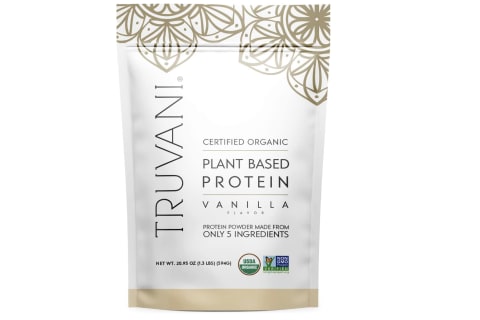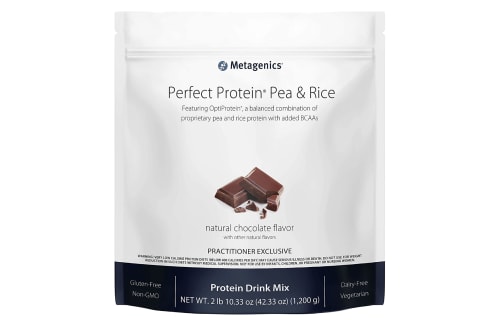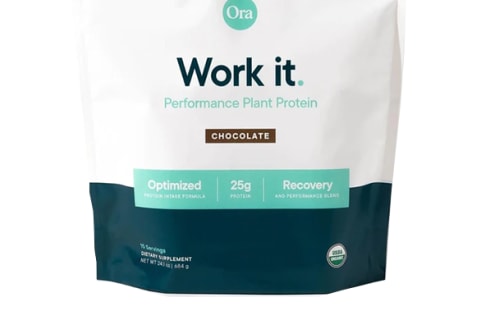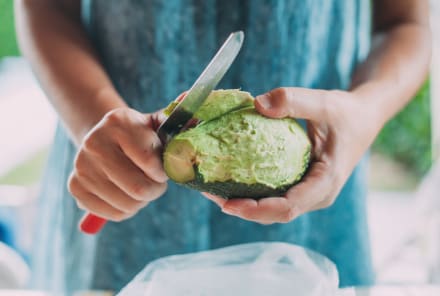Advertisement
The Best Sources Of Plant-Based Protein, From Nutrition Experts


Protein is key to a healthy diet, and it's not just in meat, eggs, or your neighborhood health store's vanilla protein powder. There are plenty of solid plant-based protein sources that are also full of nutrients.
To get a better understanding of plant-based proteins, we asked registered dietitians to explain their benefits, give us tips for incorporating them into our diets, and bust some myths. As a bonus, we prepared a grocery list of plant-based proteins to get you started.
Health benefits of plant-based protein:
They contain more antioxidants and nutrients than animal proteins.
"Plant-based sources generally have more fiber and a higher micronutrient profile," says registered dietitian Daniel Preiato, RDN, CSCS. "They contain vitamins and minerals that meat doesn't have as much of."
In fact, a study comparing over 3,000 foods1 found that plant-based foods were the most antioxidant-rich, far outpacing meat, eggs, and fish. Antioxidants2 are compounds that slow down or prevent cellular damage caused by free radicals. By consuming more antioxidants, you can keep your body strong and healthy while simultaneously fighting the effects of aging.
Plant-based foods such as fruits, vegetables, and whole grains also provide key nutrients like fiber, which can help regulate your blood sugar levels3 and keep you full.
When you eat 1 cup (or 225 grams) of cooked spinach4, for example, you're getting in not only 6 grams of protein but also 60.6 milligrams of vitamin C, 134 milligrams of calcium, and 1,600 milligrams of fiber—all essential nutrients for your body's well-being that are lacking in meat products.
They tend to be more sustainable than animal proteins.
Eating more plant-based foods can help reduce your carbon footprint and contribute to a healthier planet.
The world population is growing exponentially, and it's estimated that by 2030, there will be nearly nine billion mouths to feed, putting a strain on our planet's resources and infrastructure.
Though regenerative grazing practices can make them more sustainable, meat products usually require far more land, energy, and other resources to grow than plants do. According to The World Counts, only 2.5 billion people could be fed if everyone ate the same meat-based diet as the average American.
They can help improve your metabolic health.
Despite the fact that protein is an essential nutrient, studies show those who consume large amounts of red and white meat are at greater risk of developing high cholesterol5 and high blood pressure6.
Balancing your protein consumption with plant-based options, such as fruits and vegetables, legumes, or a quality vegan protein powder, can help improve your metabolic health.
They can aid in weight loss.
Plus, most plant-based proteins are naturally high-volume foods, which means you can eat a larger amount of them for fewer calories.
They can be very affordable.
Depending on where you live and the types of foods you buy, a plant-based diet can be significantly cheaper than a meat-centered one.
While prepackaged vegan snacks can be pricey, whole plant proteins can help save you a lot of money.
"There are countless vegan whole-food options that are super affordable," says Preiato, giving foods like fruits, vegetables, grains, legumes, and tofu, as examples. "Focus on buying plant-based foods that are minimally processed, as this will typically greatly reduce the cost," he adds.
Often, local farmers markets are the best place to buy fruits and vegetables since they only produce what is in season, so the prices can be much lower than in grocery stores that import items.
Drawbacks of plant-based protein:
They're less bioavailable than animal proteins.
Plant-based proteins are less bioavailable than animal proteins, which means they're not as easily absorbed by the body and may cause digestive discomfort.
"This is because many plant protein foods contain carbohydrates that must be broken down through fermentation in the intestines—producing gas instead of being efficiently absorbed by the GI tract," says pediatric nutritionist Gabrielle McPherson, RDN.
Though, there doesn't seem to be much to worry about, as the difference in absorption compared to animal products is only about 10 to 20%8. "If you eat these foods regularly, you should experience less gas over time," adds McPherson.
They're lower in protein than animal products.
While you can vary the types of plant proteins you eat in a day, you will still need to eat larger servings of them to meet your daily protein needs.
Most plant proteins are incomplete.
There are nine essential amino acids, including isoleucine, leucine, and lysine, needed for your body to function—and they can only be obtained through your diet. Animal proteins contain the proper amounts of all nine and are considered complete proteins. Most plant proteins are incomplete since they don't contain all nine in the right amounts12.
However, if you eat a variety of plant proteins each day, you can still cover all your bases to get the essential amino acids you need.
They may contain allergens.
When fast-food chains began offering meatless burgers and animal-free chicken strips, the food industry was transformed. Mycoprotein is a type of protein that comes from a fungus and is often used to make these meatless alternatives. While mycoproteins are a great source of protein, there is conflicting information regarding their safety. The naturally occurring fungus or mold that makes up mycoprotein is a potential allergen and has been found to cause adverse reactions, from vomiting to diarrhea13.
Which plant-based sources are the most nutritious?
You can get all the protein you need from plants, while still covering the rest of your nutritional bases. Here are 10 examples of plant-based proteins that are not only highly nutritious but also tasty and versatile:
Legumes
Legumes are a family of plants that include beans, peas, lentils, and chickpeas. "Adding just ½ cup of beans to your meals can provide around eight additional grams of protein," says Preiato.
As part of a well-balanced diet, legumes are an excellent source of vitamins and minerals, helping to maintain healthy blood sugar levels and cholesterol14.
- Red kidney beans:15.3 grams of protein15 per cup
- Black beans:15.2 grams of protein16 per cup
- Lentils:18 grams of protein17 per cup
- Green peas: 8.58 grams of protein18 per cup
- Chickpeas: 14.5 grams of protein19 per cup
Nuts
Even though nuts are mostly fats, they provide a decent amount of protein too. Nuts also contain a wide variety of nutrients, including omega-3 fatty acids and polyphenols, with walnuts containing the most polyphenols20. It's also easy to add them to almost anything. "Do you make instant oatmeal when you get to the office? Bring a tablespoon of hemp seeds or ground walnuts to sprinkle into it," says McPherson.
- Peanuts: 23.2 grams of protein21 per 100 grams
- Pistachios: 20.5 grams of protein22 per 100 grams
- Almonds: 21.4 grams of protein23 per 100 grams
- Cashews: 17.4 grams of protein24 per 100 grams
- Hazelnuts: 13.5 grams of protein25 per 100 grams
Whole grains
One cup of cooked oatmeal contains about 5 grams of protein26 and 4 grams of fiber, both of which are essential for your daily needs. Even better? Whether you want yours savory or sweet, there's no end to the toppings you can use on your bowl of oats. Quinoa is another nutrient- and antioxidant-rich grain, plus it's gluten-free and contains the right amounts of all nine essential amino acids27.
- Kamut: 9.82 grams of protein28 per cup
- Amaranth: 9.35 grams of protein29 per cup
- Quinoa: 8.14 grams of protein11 per cup
- Couscous: 5.95 grams of protein30 per cup
- Oats: 5.94 grams of protein31 per cup
TRY THEM IN: Raw Carrot Cake Overnight Oatmeal, Greens & Grains Salad
Seeds
Some seeds are considered superfoods for a reason. Take chia seeds: "They're packed with nutrients like magnesium, calcium, fiber, omega-3s, and even antioxidants32 to help fight disease," says women's health dietitian Valerie Agyeman, RDN. "They're loaded with protein too—just 1 ounce contains 5 grams33."
High-protein seeds like chia seeds, hemp seeds, flax seeds, and sunflower seeds can be added to virtually anything, including yogurt, smoothies, or salads, making it easy for you to incorporate them into your diet.
- Sunflower seeds: 29.1 grams of protein34 per cup
- Pumpkin seeds: 11.9 grams of protein35 per cup
- Chia seeds: 4.68 grams of protein33 per 1 ounce
- Hemp seeds: 9.48 grams of protein36 per 3 tablespoons
TRY THEM IN: Chia Pudding, Spiced Savory Granola
Soy products
Soy products37, such as tempeh, tofu, and edamame, make an excellent meat substitute for vegetarians and non-vegetarians alike. Tofu and tempeh provide protein as well as vitamins C, A, and calcium, while ⅔ cup of edamame38 delivers 9 grams of protein, making them a satiating snack (sprinkle with salt if you want more flavor!).
- Tofu: 43.6 grams of protein39 per cup
- Edamame: 18.4 grams of protein40 per cup
- Tempeh: 33.7 grams of protein41 per cup
TRY THEM IN: Plant-Based "Meatballs," Plant-Powered Green Dip
Plant protein powders
If you're low on time or don't feel like eating a full meal, you can whip up a quick shake using a vegan protein powder. Some of the most common types include pea protein, soy protein, and hemp protein, and they typically contain about 20 grams of protein per serving.
mbg's picks for clean plant protein powders:
Vegetables & leafy greens
When you think of protein, you probably don't think of leafy greens or vegetables. But with 4 grams of protein 42and fiber per cup, Brussels sprouts are one protein-rich plant. They also provide 24% of your daily recommended value for vitamin A as well as over 100% of your daily value for vitamins C and K. Other high-protein vegetables include spinach, asparagus, and artichoke hearts.
- Spinach: 0.85 gram of protein43 per cup
- Kale: 0.61 gram of protein44 per cup
- Watercress: 0.78 gram of protein45 per cup
- Mustard greens: 1.6 grams of protein46 per cup
Potatoes
In case anyone needed any more motivation to eat potatoes, it turns out that they actually are quite nutritious when cooked properly. There are approximately 4 grams of protein47 in a 100-gram (medium-sized) potato. Baked potatoes are also a great source of potassium, which helps to regulate blood pressure48 and maintain normal muscle and nerve function.
For a more nutritious and flavorful potato, avoid frying it in vegetable oil, and instead bake or broil it with some garlic to enhance its flavor.
- Russet potatoes: 2.63 grams of protein49 per 100 grams
- Red potatoes: 2.3 grams of protein50 per 100 grams
- White potatoes: 2.1 grams of protein51 per 100 grams
TRY THEM IN: Vegan Creamy Sweet Potato Soup, Chunky Root Vegetable Soup
Nutritional yeast
While the best part of nutritional yeast is definitely its cheese-like flavor, it doesn't end there; nutritional yeast is also a great source of B vitamins like thiamine and riboflavin, high in zinc and fiber, and it contains plenty of protein, with just 2 tablespoons containing 3 grams.52 As an added bonus, it can be used as a flavoring on a variety of foods, including pizza, popcorn, rice, or vegetables.
TRY THEM IN: Tofu Breakfast Bites, Ribollita With White Beans & Kale
Plant-based protein myths:
Myth #1: You can't fill your protein needs from plants.
While you may have to be a bit more strategic when following a vegan diet, you can certainly get enough protein from just plants. Foods such as green vegetables, tofu, seeds, quinoa, and legumes have significant protein content, offer other nutrients essential to health, and can be prepared in a variety of ways.
Myth #2: Plant protein won't help you build muscle.
Milk-derived whey protein is often associated with muscle building, but the myth that plant protein won't promote muscle growth has long been debunked53. If you want to grow muscle, both animal and plant proteins can help—but you'll need to pair them with resistance exercises that put your muscles under stress too.
Myth #3: Plant proteins cost too much.
Finally, eating plant-based does not necessarily mean spending a lot. Buying foods in bulk, such as grains and vegetables, plus complete proteins like quinoa, could cost you about $30 a week, which is about the price of one quality steak.
Tips for eating more plant-based protein:
- Work it into breakfast: "A lot of people don't get a good amount of protein at breakfast time, making it pretty difficult to make up for it throughout the day," Agyeman says. Adding plant-protein food sources will keep you feeling energized, satiated, and ready to start your day." She recommends whipping up a tofu scramble, breakfast burrito with beans, chia pudding, or pistachio muffins in the mornings, or prepping them the night before for a protein-packed breakfast.
- Use it as a thickener: "To slightly thicken a soup and make it more plant-powered, you can puree white beans and stir them into your soup," recommends McPherson.
- Incorporate it into dishes you already eat: "Adding plant proteins to the foods you already enjoy is the best way to start eating more," McPherson says. For example, if you already drink a smoothie after weight training, why not add a scoop of vegan protein powder to the mix? For your next Taco Tuesday, consider swapping meat for a quinoa-based taco filling. "Salads and power bowls are amazing vehicles for plant proteins, too—swap croutons for homemade crunchy roasted peas or chickpeas," McPherson suggests.
- Don't forget about the snacks: Eating plant-based high-protein snacks like nuts or seeds can help you meet your protein needs and sneak in some extra nutrients, says Preiato. You can add them to smoothies, rice cakes, yogurt bowls, or oatmeal, or eat them straight up!
FAQ
What plant-based food is high in protein?
Plant-based foods, such as beans, green vegetables, and nuts, are protein-rich, with 10 to 15% of their calories coming from protein. Lentils are particularly high in protein, delivering 18 grams per cup (not to mention, a ton of other nutritional benefits).
How do you get protein on a plant-based diet?
Most plant-based foods or snacks, such as legumes, broccoli, and green peas, are protein- and fiber-rich, thus helping you meet your daily nutritional requirements and stay full for longer. Soy foods like tofu and tempeh, nuts like almonds and pistachios, and whole grains like oats and quinoa are also great sources of protein for a plant-based diet.
Can you eat too much plant protein?
Even if it seems that consuming more plant protein would provide more benefits, it is possible to overdo anything. Excessive consumption of plant protein (well above 2 grams per kilogram of body weight) over a long period may cause adverse reactions such as nausea and discomfort. Those with existing kidney and liver issues will also want to monitor their protein intake more closely.
The takeaway
Getting enough protein from a plant-based diet is easier than you might think. Besides being delicious, plant proteins offer unique health benefits and tend to be less harmful to the environment.
53 Sources
- https://www.ncbi.nlm.nih.gov/pmc/articles/PMC2841576/
- https://www.eatright.org/health/essential-nutrients/vitamins/antioxidants-protecting-healthy-cells
- https://pubmed.ncbi.nlm.nih.gov/19335713/
- https://fdc.nal.usda.gov/fdc-app.html#/food-details/1999633/nutrients
- https://www.sciencedirect.com/science/article/pii/S0002916522011492?via%3Dihub
- https://pubmed.ncbi.nlm.nih.gov/31387433/
- https://www.ncbi.nlm.nih.gov/pmc/articles/PMC8210981/
- https://www.ncbi.nlm.nih.gov/pmc/articles/PMC6723444/
- https://fdc.nal.usda.gov/fdc-app.html#/food-details/331960/nutrients
- https://fdc.nal.usda.gov/fdc-app.html#/food-details/174291/nutrients
- https://fdc.nal.usda.gov/fdc-app.html#/food-details/168917/nutrients
- https://www.ncbi.nlm.nih.gov/pmc/articles/PMC6893534/
- https://pubmed.ncbi.nlm.nih.gov/29567357/
- https://www.ncbi.nlm.nih.gov/pmc/articles/PMC4608274/
- https://fdc.nal.usda.gov/fdc-app.html#/food-details/175194/nutrients
- https://fdc.nal.usda.gov/fdc-app.html#/food-details/173735/nutrients
- https://fdc.nal.usda.gov/fdc-app.html#/food-details/175254/nutrients
- https://fdc.nal.usda.gov/fdc-app.html#/food-details/170420/nutrients
- https://fdc.nal.usda.gov/fdc-app.html#/food-details/173757/nutrients
- https://pubmed.ncbi.nlm.nih.gov/22187094/
- https://fdc.nal.usda.gov/fdc-app.html#/food-details/2515376/nutrients
- https://fdc.nal.usda.gov/fdc-app.html#/food-details/2515379/nutrients
- https://fdc.nal.usda.gov/fdc-app.html#/food-details/2346393/nutrients
- https://fdc.nal.usda.gov/fdc-app.html#/food-details/2515374/nutrients
- https://fdc.nal.usda.gov/fdc-app.html#/food-details/2515375/nutrients
- https://fdc.nal.usda.gov/fdc-app.html#/food-details/557415/nutrients
- https://www.ncbi.nlm.nih.gov/pmc/articles/PMC7434868/
- https://fdc.nal.usda.gov/fdc-app.html#/food-details/169744/nutrients
- https://fdc.nal.usda.gov/fdc-app.html#/food-details/170683/nutrients
- https://fdc.nal.usda.gov/fdc-app.html#/food-details/169700/nutrients
- https://fdc.nal.usda.gov/fdc-app.html#/food-details/171675/nutrients
- https://www.ncbi.nlm.nih.gov/pmc/articles/PMC4926888/
- https://fdc.nal.usda.gov/fdc-app.html#/food-details/170554/nutrients
- https://fdc.nal.usda.gov/fdc-app.html#/food-details/170562/nutrients
- https://fdc.nal.usda.gov/fdc-app.html#/food-details/170188/nutrients
- https://fdc.nal.usda.gov/fdc-app.html#/food-details/170148/nutrients
- https://www.sciencedirect.com/science/article/pii/S2666154321001678#
- https://fdc.nal.usda.gov/fdc-app.html#/food-details/2384458/nutrients
- https://fdc.nal.usda.gov/fdc-app.html#/food-details/172475/nutrients
- https://fdc.nal.usda.gov/fdc-app.html#/food-details/168411/nutrients
- https://fdc.nal.usda.gov/fdc-app.html#/food-details/174272/nutrients
- https://fdc.nal.usda.gov/fdc-app.html#/food-details/169971/nutrients
- https://fdc.nal.usda.gov/fdc-app.html#/food-details/168462/nutrients
- https://fdc.nal.usda.gov/fdc-app.html#/food-details/168421/nutrients
- https://fdc.nal.usda.gov/fdc-app.html#/food-details/170068/nutrients
- https://fdc.nal.usda.gov/fdc-app.html#/food-details/169256/nutrients
- https://fdc.nal.usda.gov/fdc-app.html#/food-details/2346401/nutrients
- https://www.cdc.gov/salt/potassium.htm
- https://fdc.nal.usda.gov/fdc-app.html#/food-details/170030/nutrients
- https://fdc.nal.usda.gov/fdc-app.html#/food-details/170435/nutrients
- https://fdc.nal.usda.gov/fdc-app.html#/food-details/170434/nutrients
- https://fdc.nal.usda.gov/fdc-app.html#/food-details/2411476/nutrients
- https://pubmed.ncbi.nlm.nih.gov/25628520/
Watch Next
Enjoy some of our favorite clips from classes
Enjoy some of our favorite clips from classes
What Is Meditation?
Mindfulness/Spirituality | Light Watkins
Box Breathing
Mindfulness/Spirituality | Gwen Dittmar
What Breathwork Can Address
Mindfulness/Spirituality | Gwen Dittmar
The 8 Limbs of Yoga - What is Asana?
Yoga | Caley Alyssa
Two Standing Postures to Open Up Tight Hips
Yoga | Caley Alyssa
How Plants Can Optimize Athletic Performance
Nutrition | Rich Roll
What to Eat Before a Workout
Nutrition | Rich Roll
How Ayurveda Helps Us Navigate Modern Life
Nutrition | Sahara Rose
Messages About Love & Relationships
Love & Relationships | Esther Perel
Love Languages
Love & Relationships | Esther Perel
What Is Meditation?
Box Breathing
What Breathwork Can Address
The 8 Limbs of Yoga - What is Asana?
Two Standing Postures to Open Up Tight Hips
How Plants Can Optimize Athletic Performance
What to Eat Before a Workout
How Ayurveda Helps Us Navigate Modern Life
Messages About Love & Relationships
Love Languages
Advertisement

This Underconsumed Nutrient Helps Fight Gum Inflammation, Study Shows
Molly Knudsen, M.S., RDN

Research Shows Cognitive Longevity Depends On These 3 Critical Vitamins
Molly Knudsen, M.S., RDN

This Underconsumed Nutrient Helps Fight Gum Inflammation, Study Shows
Molly Knudsen, M.S., RDN

This Underconsumed Nutrient Helps Fight Gum Inflammation, Study Shows
Molly Knudsen, M.S., RDN

Research Shows Cognitive Longevity Depends On These 3 Critical Vitamins
Molly Knudsen, M.S., RDN

This Underconsumed Nutrient Helps Fight Gum Inflammation, Study Shows
Molly Knudsen, M.S., RDN














